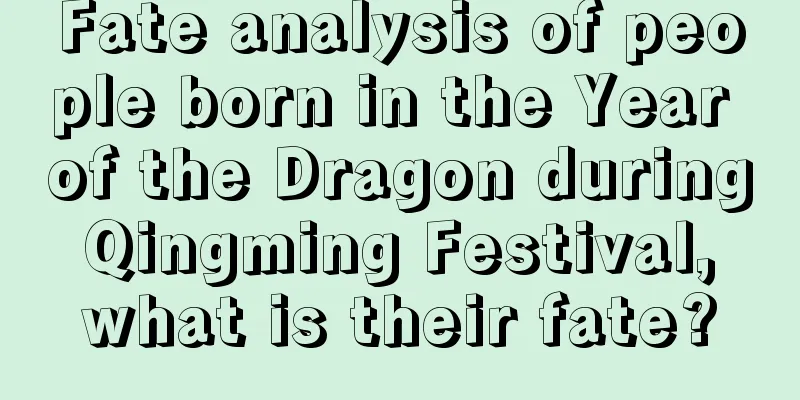What are the customs of the Chinese Valentine's Day? Is the 2020 Chinese Valentine's Day suitable for funerals and burials of the deceased?

Introduction: Chinese Valentine's Day is one of the traditional festivals, and there are many customs about it. So what are the customs of Chinese Valentine's Day? Is it suitable to hold funerals and bury the deceased on Chinese Valentine's Day in 2020? Legend has it that every seventh month of the lunar calendar, the gates of the underworld open and hundreds of ghosts roam at night, so the entire seventh month is called the Ghost Month. So are all the days in the seventh lunar month of 2020 bad? Let’s go to Mr. Shui Mo’s website and find out.What are the customs of the Chinese Valentine’s Day?Qixi Festival customs: women worship the moonIn the culture of the Xia people, the ancient custom of worshiping the moon god was mostly on the new moon day, that is, the 17th or 27th day. It is believed that the 15th day of the month, which was popular in the Han Dynasty, was also a slight revision of the 27th day. In ancient times, many women had the custom of worshiping the moon. In traditional culture, the moon has always been a symbol of good fortune for women. They often pray or confide their deepest thoughts to the moon. There has been a tradition of women worshipping the moon since ancient times, especially on the Chinese Valentine's Day and the Mid-Autumn Festival. The legend of Diao Chan offering sacrifices to the moon is probably the most touching scene. Transformation and seeking a child On the Chinese Valentine's Day, people use wax to make various images, such as the characters in the story of the Cowherd and the Weaver Girl, or the shapes of vultures, mandarin ducks, and other animals, and place them on the water to float, which is called "floating on water." Among them is a wax baby doll called "Huasheng". Women bought them home and let them float on the water and soil, believing it was a good omen for having children. Qixi Festival customs: planting seeds to pray for a child According to the old custom, a few days before the Chinese Valentine's Day, a layer of soil was put on a small wooden board, and corn seeds were sown to grow into green seedlings. Some small huts, flowers and trees were then placed on it to make it look like a small village of farmers, which was called "shell board". Or mung beans, red beans, wheat, etc. were soaked in a porcelain bowl, and waited for them to grow inch-long sprouts, and then tied into a bundle with red or blue silk ropes. This was called "seeding life", also known as the "five-life basin" or "flower basin". It is also called "Pao Qiao" in various parts of the south. The grown bean sprouts are called Qiao Ya, and people even use Qiao Ya to replace needles and throw them on the water to pray for cleverness. Various images are also sculpted out of wax, such as the characters in the story of the Cowherd and the Weaver Girl, or the shapes of vultures, mandarin ducks, and other animals, and placed on the water to float, which is called "floating on water." There were also wax baby dolls that women would buy and place them in water and soil to float them home, believing that this would bring good luck in having a child, a practice called "transformation." Qixi Festival customs: Tianhe Night Talk On the night of the Chinese Valentine's Day, many young girls will secretly hide under a shed full of lush pumpkins. Legend has it that if one can hear the whispers of the Cowherd and the Weaver Girl when they meet in the dead of night, the girl who is about to get married will be able to obtain this everlasting love for a thousand years. In an era of open social atmosphere, there were also lovers who would hide under the melon shed hand in hand and eavesdrop on the whispers of the Milky Way. Qixi Festival customs: worship the Weaver Girl "Worshiping the Weaver Girl" is purely a matter for young girls and young women. Most of them make appointments with their friends or neighbors in advance to host the event together with five or six people, or as many as ten people. The ceremony was held by setting up a table under the moonlight, on which were placed tea, wine, fruits, five seeds (longan, red dates, hazelnuts, peanuts, melon seeds) and other offerings; there were also a few flowers tied with red paper and inserted in a vase, and a small incense burner was placed in front of the flowers. Then, the young women and girls who had agreed to participate in the worship of the Weaver Girl fasted for a day, bathed, and came to the host's house on time. After burning incense and praying in front of the table, everyone sat around the table together, eating peanuts and melon seeds, facing the Weaver Girl constellation, and silently reciting their thoughts. For example, young girls who hope to be beautiful or marry a good husband, and young women who hope to have a baby soon, can pray silently to the Vega. We played until midnight. Is the Chinese Valentine’s Day in 2020 suitable for funerals and burials of the deceased?Lunar calendar: July 7, 2020 Gregorian calendar: August 25, 2020, Tuesday, Virgo [Today's old almanac is suitable] Pray for blessings, get married, move to a new position, fast and offer sacrifices, pray for offspring, move into a new house, seek wealth, break ground, start drilling, remove mourning clothes, accept betrothal gifts, open the market, build a house, erect pillars and beams, accept wealth, remove planting and livestock, go to school, cut clothes, wear a hairpin [Today's old almanac is unsuitable] Litigation, bed installation, construction, groundbreaking , burial, travel , go out to teach, seek medical treatmentSince burial falls within the scope of [today’s almanac taboos], it is not suitable to hold funerals or bury the deceased on Chinese Valentine’s Day in 2020! Qixi Festival food customs: eating Qiaoguo Among the festive foods for the Chinese Valentine's Day, the most famous is the Qiaoguo. Qiaoguo, also known as "Qiqiao Fruit", comes in many styles. The main ingredient of glutinous rice cake is oil flour and molasses. In "Dongjing Menghualu", it is called "Xiaoyaner" and "Fruit Food Patterns", and the patterns include Naxiang and Fangsheng. During the Song Dynasty, Qixi cookies were already sold on the streets. If you buy a pound of Qiaoguo, you will also get a pair of puppets wearing armor like door gods, known as the "Fruit Generals". The method of making Qixi Qiaoguo is: first melt the sugar in a pot into syrup, then add flour and sesame seeds, mix well and spread it on the table to roll it thin, let it cool, cut it into rectangular blocks with a knife, fold it into spindle-shaped dough embryos, and fry it in oil until golden brown. Dexterous women can also sculpt various patterns related to the Qixi legend. In addition, the fruits and vegetables used when begging for cleverness can also vary in many ways. The fruits may be carved into exotic flowers and birds, or patterns may be embossed on the surface of the melon skin, which is called "flower melon". Searching in this vast sea of people, is that person the destined one? Welcome to click on the "Premium Calculation" below for advance predictions. I wish you a perfect relationship and marriage! |
<<: Where is the direction of the God of Joy at 82 hours on the 9th lunar month of 2020?
Recommend
Can’t sign the contract on November 21st of the lunar calendar in 2017?
Introduction: Signing a contract is a relatively i...
What zodiac sign does a baby born on the third day of the eighth lunar month in 2018 belong to?
Autumn is the season of harvest. As the eighth mon...
What day is the second day of the twelfth lunar month in 2021? Can a funeral be held there?
December at the end of the year is the month when ...
Is the sixth day of the third lunar month in 2020 a good day? Is it good to sign the contract?
The pros and cons of signing a contract at differe...
Is it a good idea to move on the fourth day of the eighth lunar month in 2020? Can I move into the new home?
The eighth month of the lunar calendar is also kn...
What else do we do on Dragon Boat Festival besides eating rice dumplings? What is the Dragon Boat Festival also called?
Introduction: The Dragon Boat Festival is one of t...
Is the sixth day of the eighth lunar month in 2022 an unlucky day? Which zodiac sign is it in conflict with?
When we are chasing the future, there are often st...
Can I pick up a new car and go out on the fifteenth day of the first lunar month in 2018?
What day is the fifteenth day of the first lunar ...
Can I visit the graves and worship my ancestors on the ninth day of the first lunar month in 2019?
In our country's traditional culture, ancestor...
How is the fate of a baby chicken born on September 18th of the lunar calendar in 2017?
Introduction: The birth of a child is the most bea...
Is it suitable to break ground on March 22 of the lunar calendar in 2022? How to choose an auspicious day for breaking ground?
The third month of the lunar calendar is the trans...
Is it good to be born on the Dragon Boat Festival for people born in the Year of the Ox? What is the fate like?
The Dragon Boat Festival is the most important tra...
What day is Cold Dew in 2021? What to eat during the Cold Dew solar term?
Speaking of the Cold Dew solar term, I believe eve...
Is April 19th of the lunar calendar 2020 a good day to open a business?
Is April 19th of the lunar calendar 2020 a good d...
Can you go on a date on the Lantern Festival in 2020? Recommended heartwarming blessings for the Lantern Festival in 2020!
Introduction: The Lantern Festival is one of the t...









